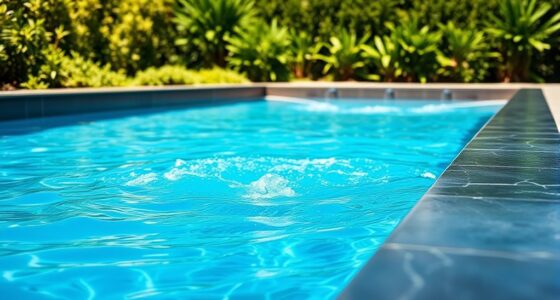To create an eco-friendly pool, choose sustainable materials like recycled wood and natural stone, and incorporate native plants around your area for natural aesthetics and environmental benefits. Install solar-powered pumps, lighting, and heating systems to reduce energy use. Consider natural filtration methods with beneficial bacteria and plants to minimize chemicals. These eco-conscious choices not only lower your environmental impact but also save you money—look further to discover how to easily transform your backyard into a sustainable oasis.
Key Takeaways
- Use solar panels for pool heating and lighting to harness renewable energy and reduce electricity costs.
- Incorporate natural filtration systems with plants and beneficial bacteria to minimize chemical use.
- Select eco-friendly construction materials like recycled composites and natural stone for sustainable pool design.
- Plant native, drought-resistant plants around the pool to enhance aesthetics and support local ecosystems.
- Install solar-powered pumps and LED lighting to maximize energy efficiency and lower environmental impact.

Creating an eco-friendly pool doesn’t mean sacrificing fun or luxury; instead, it’s about making smarter choices that benefit both your backyard and the environment. One of the most effective ways to do this is by integrating solar heating into your pool system. Solar heating uses the sun’s energy to warm your water naturally, reducing the need for electricity or gas-powered heaters. You’ll save money on energy bills while minimizing your carbon footprint. Installing solar panels on your roof or nearby can harness this renewable energy source efficiently. It’s a simple upgrade that keeps your water comfortably warm, even during cooler months, without harming the environment.
Eco-friendly pools save energy and money by using solar heating to warm water naturally.
Another sustainable feature to contemplate is natural filtration. Traditional pools often rely on chemical treatments that can harm aquatic life and irritate your skin. Natural filtration systems, on the other hand, use biological processes to keep the water clean and clear. You can incorporate a biofilter, which combines plants, beneficial bacteria, and specialized media to naturally purify the water. These systems require less maintenance and eliminate the need for harsh chemicals, making your pool safer for your family and the environment. By reducing chemical use, you also protect local wildlife and groundwater from contamination.
In addition to these technical upgrades, choosing eco-friendly materials for your pool’s construction makes a big difference. Recycled or sustainably sourced materials like composite decking or natural stone not only look beautiful but also reduce environmental impact. Incorporating native plants around your pool area creates a lush, natural aesthetic while supporting local ecosystems. These plants can act as natural filters, absorbing excess nutrients and preventing runoff into your pool. Plus, they require less water and maintenance compared to exotic species, helping you conserve resources.
Powering your pool with renewable energy sources further enhances its eco-friendliness. If you have the space, installing solar-powered pumps and lighting can cut down on electricity consumption. LED lighting, powered by solar energy, provides a beautiful glow without increasing your energy bills. When combined with solar heating and natural filtration, these features create a truly sustainable oasis that’s both luxurious and environmentally responsible. Incorporating energy-efficient technologies can maximize your pool’s sustainability and reduce ongoing costs.
Frequently Asked Questions
What Are the Costs Associated With Eco-Friendly Pool Installations?
The costs for eco-friendly pool installations vary based on size, materials, and technology, but you’ll find that the installation expenses are often comparable to traditional pools. A cost comparison shows that while eco-friendly features like solar heating and natural filtration might have higher upfront costs, they save money long-term. You should budget for specialized equipment and sustainable materials, but the benefits include reduced energy bills and environmental impact.
How Long Does Eco-Friendly Pool Equipment Typically Last?
Eco-friendly pool equipment typically lasts around 10 to 15 years, depending on usage and maintenance. You can expect good eco friendly pool durability if you choose high-quality, energy-efficient pumps, filters, and solar heaters. Regular upkeep, such as cleaning and timely repairs, extends the lifespan of your pool equipment. By investing in durable, eco-conscious components, you’ll enjoy a sustainable pool that remains efficient and functional for many seasons.
Are Solar-Powered Pools Effective in All Climates?
You might be surprised to learn that solar-powered pools can be quite effective in many climates. Solar efficiency varies with weather and sunlight, but modern systems adapt well to different conditions. In sunny regions, they excel, heating your pool effortlessly. Even in less sunny areas, climate adaptation technologies help optimize performance, ensuring you enjoy eco-friendly benefits year-round. So yes, with the right setup, solar pools work effectively across diverse climates.
What Maintenance Is Required for Eco-Friendly Pools?
You’ll need to regularly do pool cleaning to keep your eco-friendly pool in top shape, removing debris and algae. Water testing is essential to monitor pH, chlorine levels, and other chemicals, ensuring a safe environment. Since eco pools often use natural filtration or solar pumps, check these systems periodically for efficiency. Consistent maintenance helps extend your pool’s lifespan and keeps it eco-friendly and inviting for swimming.
Can Eco-Friendly Pools Be Customized for Small Spaces?
Yes, you can customize eco-friendly pools for small spaces. Focus on small space design with compact pool options like plunge pools or portable designs that fit your yard. Use sustainable materials and incorporate eco-friendly features such as solar covers or energy-efficient pumps. These choices maximize functionality while minimizing environmental impact, making it easy to enjoy a personalized, eco-friendly pool even in limited space.
Conclusion
By choosing eco-friendly materials, plants, and energy solutions, you’re not just building a pool—you’re creating a sanctuary that breathes life into your surroundings. Imagine your backyard as a lush oasis, where each sustainable choice is a ripple of change, echoing harmony with nature. Your pool becomes more than a feature; it’s a symbol of balance, renewal, and respect for the Earth. Embrace these ideas, and let your outdoor space blossom with eco-conscious beauty.









